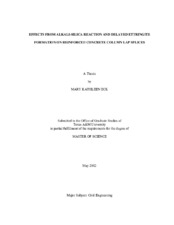| dc.description.abstract | Reinforced concrete bridge columns can deteriorate prematurely due to the alkali-silica reaction (ASR) and/or delayed ettringite formation (DEF), causing internal expansion and cracking on the surface of the concrete. The performance of the longitudinal reinforcement lap splice in deteriorated concrete columns is the focus in this research.
This thesis presents the results from the deterioration of large-scale specimens constructed and placed in an environment susceptible to ASR/DEF deterioration, the experimental results from four-point and three-point structural load tests, and an analytical model based on bending theory characterizing the specimen behavior during the structural load tests.
Fourteen large-scale specimens were constructed, placed in an environment to accelerate the ASR/DEF deterioration mechanisms, and instrumented both internally and externally to measure the internal concrete expansions, and surface expansions and crack widths. In addition, two control specimens were constructed and kept in a laboratory, preventing ASR/DEF deterioration. Post-tensioning was used to simulate axial load on a bridge column. Structural load tests were performed on eight specimens with no ASR/DEF damage to late stage ASR and minimal DEF damage. Comparing the specimen behaviors during the loading testing, it was found that the yield strength increased about 5-15%, and post-cracking stiffness up to first yielding of the deteriorated specimens was about 25-35% stiffer than the control specimens. The increased specimen strength and stiffness likely occurred from volumetric expansion due to ASR/DEF damage which engaged the reinforcement, further confining the concrete and causing a beneficial increase in the axial post-tensioning load. The analytical model matched the control specimens well and matched the non-control specimens when the axial load was increased. | en |


